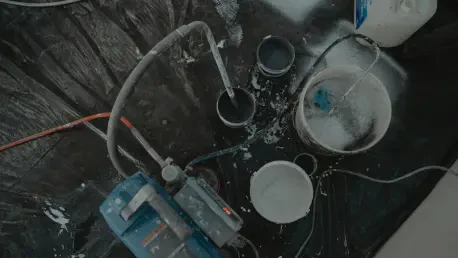Industrial mixing, a cornerstone of sectors including food production, pharmaceuticals, chemicals, and construction, has undergone a remarkable transformation due to robotics and automation. Traditionally reliant on human expertise and mechanical systems, these processes often had a significant margin for error, leading to batch rejections, increased waste, and compromised product quality. Currently, as industries strive for precision, repeatability, and efficiency, robotics and automation have redefined these mixing processes. This technological shift improves the consistency and control of mixing operations while enhancing productivity and safety. Let’s delve deeper into how robotics are revolutionizing industrial mixing.
Precision and Efficiency Enhanced by Robotics
Unmatched Precision in Mixing Processes
Robotics in industrial mixing offer unparalleled accuracy, precision, and repeatability, crucial for maintaining product quality. Utilizing robotic arms for ingredient dispensing ensures precise ratios and sequencing, minimizing human error. Such precision is critical when dealing with sensitive materials like pharmaceuticals and food products, where strict adherence to recipes and proportions is necessary to assure effectiveness and safety. Robotic systems, integrated with advanced sensors and control mechanisms, monitor multiple variables such as temperature, viscosity, and shear rate in real-time. This allows prompt parameter adjustments, reacting to changes during the process and providing consistency in the production line, averting potential batch failures, and ensuring adherence to desired quality standards.
Moreover, introducing smart sensors plays an instrumental role in industrial mixing efficiency. These sensors continuously track conditions, offering detailed insights into parameters like pH levels, temperature, and mixing torque. The data collected allows robotic systems to make necessary adjustments, maintaining the integrity of the mixing process. This adaptability is crucial for dealing with unexpected variations, such as increases in viscosity, which can affect the consistency and quality of the final product. This steady control enhances process repeatability, ensuring uniformity across different batches.
Automation Reducing Human Error and Increasing Safety
Significant advantages of automation in mixing operations include reducing human error. In tasks requiring repetitive motions or posing hazards, robots outperform humans in precision and reliability. Automated systems handle ingredient loading, container management, and equipment cleaning with exactitude, reducing contamination risks and enhancing worker safety. This shift boosts operational safety and promotes higher hygiene standards, pivotal in sectors like food and pharmaceuticals. By minimizing direct human involvement in sensitive production stages, automation ensures sanitary integrity and product quality.
Furthermore, industrial automation provides a robust framework for managing sophisticated mixing operations. Embedded within advanced programmable logic controllers (PLCs) and Supervisory Control and Data Acquisition (SCADA) systems, automation supervises diverse aspects of the process. This includes sequencing, scheduling, data logging, and predictive maintenance. Such intelligent systems allow remote activity oversight and control, making the process more agile and responsive. Automation reduces downtime and enhances reliability, critical for maintaining an efficient production line.
Economic and Operational Impact
Boosting Productivity and Enhancing Product Quality
Incorporating robotics and automated systems in industrial mixing has significantly increased productivity. Unlike humans, robots function tirelessly without fatigue, enabling 24/7 operations, increasing throughput as cycle times are reduced and output maximized. Automation reliably manages process control, allowing businesses to achieve higher efficiency and consistent product quality, drastically minimizing variance and compliance failures. This is advantageous in industries where maintaining uniformity is critical, such as pharmaceuticals, where even slight deviations could have severe implications on consumer safety.
Enhanced product quality is another substantial benefit of automation in industrial mixing. With robots ensuring identical conditions across each batch, variation is minimized, and adhering to quality standards becomes routine rather than an exception. This consistency guarantees products meet stringent standards, reducing rejection and recall rates. Consequently, customer trust and brand reputation improve, enhancing market competitiveness. As a result, businesses experience increased client satisfaction and prolonged market presence.
Cost Reduction through Automation
Transitioning to robotic mixing systems brings significant cost savings, contributing to decreased labor and operational costs. With fewer needed operators to manage repetitive and manual tasks, labor costs are lowered, allowing resource allocation to critical areas like innovation and development. Additionally, automated systems optimize energy consumption and minimize error-induced waste, further reducing operational expenses. This results in a streamlined production process, strengthening enterprises’ bottom lines. Consequently, industries can reinvest savings into enhancing technology or exploring new market opportunities.
Safety improvements are another critical benefit, particularly in mixing hazardous materials or operating in extreme conditions. Robots and automation thrive in risky environments, such as those with high temperatures or toxic substance exposure, reducing risks to human employees. Performing under dangerous conditions secures workers’ safety and improves reliability and efficiency. Automated systems ensure emergency shutdowns and safety protocols are rapidly enacted, providing added layers of industrial environment security.
Real-World Applications Across Various Sectors
Innovations in Food and Pharmaceutical Industries
The food and beverage sector has notably benefited from integrating robotic systems into industrial mixing operations. Hygiene standards are vital in this industry, and robotic systems efficiently deliver hygienic mixing processes with precise ingredient measurement and minimal human contact. Automation platforms uphold cleanliness and dietary protocol compliance and ensure recipe precision, crucial for maintaining flavor and texture standards in food products. Industry-specific applications demonstrate how robots assure consistency and quality, extending food products’ shelf life and market appeal.
Pharmaceutical manufacturing, characterized by rigorous regulations and stringent quality requirements, relies heavily on automation to safeguard product integrity during mixing. Precise control over parameters like time, temperature, and pressure is vital. Robots deftly manage these tasks, ensuring sterile ingredient handling and minimizing contamination risks. Automation systems offer real-time monitoring and data analytics capabilities, enabling pharmaceutical companies to enhance manufacturing processes, adhere to regulatory standards, and reduce waste. Through robotics, these enhancements improve pharmaceutical products’ efficacy and safety, ultimately benefiting patients and consumers.
Advancements in Chemical and Construction Industries
In the chemicals sector, robotics and automation manage complex exothermic reactions with precision. Automated systems enable real-time parameter adjustments, crucial for maintaining safe and effective processing conditions. Robotics ensure safe, accurate reactive agent addition, reducing potential exposure to hazardous chemicals. Automation of these tasks significantly enhances efficiency and safety, ensuring chemical products meet the highest quality standards.
Meanwhile, robotics has drastically improved construction materials’ accuracy and consistency in mixing processes. Automation guarantees adherence to stringent mixtures standards, with robotic systems precisely dosing aggregates and additives. These qualities are crucial for ensuring the durability and strength of construction materials. Automation enables manufacturers to swiftly adapt to varying requirements, offering diverse solutions for different construction needs. By embracing robotics and automation, the construction industry ensures consistent quality and performance in materials while reducing waste and enhancing sustainability.
Overcoming Challenges and Shaping the Future
Addressing Implementation Challenges
Despite numerous advantages, transitioning to robotic systems in industrial mixing presents challenges. The high initial investment required for purchasing and integrating robotics and automation technologies can be an obstacle, particularly for smaller manufacturers with limited budgets. However, this challenge is gradually overcome as modular automation platforms and more affordable robotic solutions become available, making it increasingly viable for small and medium-sized businesses to embrace advanced technologies without prohibitively high costs.
Comprehensive training is essential to maximize robotics benefits in industrial mixing. Operators and maintenance staff must possess the skills necessary to manage and troubleshoot these sophisticated systems. Workforce development initiatives, training programs, and partnerships with technology providers are critical for equipping the workforce with the necessary expertise. By focusing on education and skills development, industries can fully harness robotics and automation potential while ensuring a seamless transition to advanced solutions.
Future Trends in Industrial Mixing
The convergence of robotics, artificial intelligence, and automation paves the way for exciting future trends in industrial mixing. One promising development involves digital twins, which create virtual replicas of mixing processes. This technology allows operators to simulate changes, optimize performance, and address issues without halting actual operations. Digital twins provide valuable insights into mixing processes, enabling industries to explore new methodologies and enhance efficiencies.
Artificial intelligence presents opportunities for extensive data analysis, outcome prediction, anomaly detection, and process improvement recommendations. With AI-driven process optimization, manufacturers can better adapt to changing demands and anticipate potential challenges. AI tools facilitate proactive maintenance scheduling, optimize mixing parameters, and improve overall production line efficiency. Collaborative robots, or Cobots, offer another promising avenue by working alongside humans to assist in tasks such as ingredient loading and cleaning, blending the best of automation and human operation.
Embracing Intelligent Mixing Solutions
Robotics in industrial mixing ensures unmatched accuracy, precision, and repeatability, essential for maintaining product excellence. Robotic arms used for ingredient dispensing guarantee precise ratios and sequences, significantly reducing human error. This precision is essential in industries such as pharmaceuticals and food production, where strict compliance with recipes and proportions is critical for safety and effectiveness. By integrating advanced sensors and control mechanisms, these robotic systems monitor numerous variables, including temperature, viscosity, and shear rate, in real-time. This capability allows swift parameter adjustments, responding to changes during production. Consequently, they ensure production line continuity, preventing potential batch failures, and maintaining quality standards.
Additionally, using smart sensors dramatically enhances industrial mixing efficiency. These devices continuously assess mixing conditions, offering comprehensive insights into parameters like pH levels, temperatures, and mixing torques. By analyzing this data, robotic systems can make necessary adjustments to safeguard the integrity of the mixing process. This adaptability is particularly vital for handling unforeseen changes, such as increased viscosity, which can influence the final product’s consistency and quality. The subsequent stable control elevates process repeatability, guaranteeing uniformity across various batches, ensuring consistent and high-quality output.









